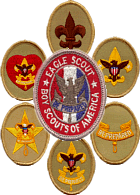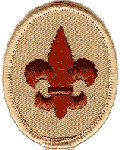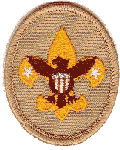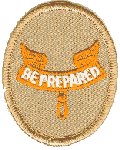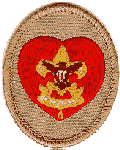|
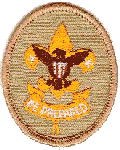 FIRST CLASS RANK REQUIREMENTS (2008) FIRST CLASS RANK REQUIREMENTS (2008)
- Demonstrate how to find
directions during the day and at night without using a compass.
- Using a compass, complete
an orienteering course that covers at least one mile and requires
measuring the height and/or width of designated items (tree, tower,
canyon, ditch, etc.)
- Since joining, have
participated in ten separate troop/patrol activities (other than
troop/patrol meetings), three of which included camping overnight.
- a. Help plan a patrol menu
for one campout -- including one breakfast, lunch, and dinner - that
requires cooking at least two of the meals. Tell how the menu includes
the four basic food groups and meets nutritional needs.
b. Using the menu
planned in requirement 4a, make a list showing the cost and food amounts
needed to feed three or more boys and secure the ingredients.
c. Tell which
pans, utensils, and other gear will be needed to cook and serve these
meals.
d. Explain the
procedures to follow in the safe handling and storage of fresh meats,
dairy products, eggs, vegetables, and other perishable food products.
Tell how to properly dispose of camp garbage, cans, plastic containers,
and other rubbish.
e. On one campout,
serve as your patrol's cook. Supervise your assistant(s) in using a
stove or building a cooking fire. Prepare the breakfast, lunch, and
dinner planned in requirement 4a. Lead your patrol in saying grace at
the meals and supervise cleanup.
- Visit and discuss with a
selected individual approved by your leader (elected official, judge,
attorney, civil servant, principal, teacher) your Constitutional rights
and obligations as a U.S.
citizen.
- Identify or show evidence
of at least ten kinds of native plants found in your community.
- a. Discuss when you should
and should not use lashings
b. Demonstrate
tying the timber hitch and clove hitch and their use in square, shear,
and diagonal lashings by joining two or more poles or staves
together.
c. Use lashing to
make a useful camp gadget.
- a. Demonstrate tying the
bowline knot and describe several ways it can be used.
b. Demonstrate
bandages for a sprained ankle and for injuries on the head, the upper
arm, and the collarbone.
c. Show how to
transport by yourself, and with one other person, a person:
1.
from a smoke-filled room
2. with a sprained
ankle, for at least 25 yards.
d. Tell the five most common
signs of a heart attack. Explain the steps (procedures) in cardiopulmonary
resuscitation (CPR).
9.
a. Tell what
precautions must be taken for a safe trip afloat. .
b. Successfully complete
the BSA swimmer test. .
c. With a helper and a practice victim, show a line rescue
both as a tender and as rescuer. (The practice victim should be approximately
30 feet from the shore in deep water.)
10.
Demonstrate scout spirit by living the Scout Oath (Promise)
and Scout Law in your everyday life.
11.
Tell someone who is eligible to join Boy Scouts, or an
inactive Boy Scout, about your Troop’s activities. Invite him to a
troop outing, activity, service project, or meeting. Tell him how to join, or
encourage the inactive Boy Scout to become active.
12.
Describe the three things you should avoid doing related
to use of the internet. Describe a cyberbully and how you should respond to
one.
13.
Participate in a Scoutmaster conference.
14.
Complete your board of review.
|
|
SWIMMER TEST
The
swimmer test demonstrates the minimum level of swimming ability required for
safe deep-water swimming. The various components of the test evaluate the
several skills essential to this minimum level of swimming ability:
Jump feet first into
water over the head in depth, level off, and begin swimming. Swim 75 yards in
a strong manner using one or more of the following strokes: sidestroke,
breaststroke, trudgen, or crawl; then swim 25 yards using an easy, resting
backstroke. The 100 yards must be completed in one swim without stops and
include at least one sharp turn. After completing the swim, rest by
floating.
The test administrator
must objectively evaluate the individual performance of the test, and in so
doing should keep in mind the purpose of each test element.
- "Jump feet first into
water over the head in depth, level off, and begin
swimming..."
The
swimmer must be able to make an abrupt entry into deep water and begin
swimming without any aids. Walking in from shallow water, easing in from the
edge or down a ladder, pushing off from side or bottom, or gaining forward
momentum by diving do not satisfy this requirement.
- "...Swim 75 yards in a
strong manner using one or more of the following strokes: sidestroke,
breaststroke, trudgen, or crawl;..."
The
swimmer must be able to cover distance with a strong, confident stroke. The
75 yards must not be the outer limit of the swimmer's ability; completion of
the distance should give evidence of sufficient stamina to avoid undue risks.
Dog-paddling and strokes repeatedly interrupted and restarted are not
sufficient; underwater swimming is not permitted. The itemized strokes are
inclusive. Any strong side or breaststroke or any strong overarm stroke
(including the back crawl) is acceptable.
- "...swim 25 yards
using; an easy, resting backstroke..."
The
swimmer must indicate the ability to execute a restful, free-breathing
backstroke that can be used to avoid exhaustion during swimming activity.
This element of the test necessarily follows the more strenuous swimming
activity to show that the swimmer is, in fact, able to use the backstroke as
a relief from exertion. The change of stroke must be accomplished in deep
water without any push- off or other aid. Any variation of the elementary may
suffice if it clearly provides opportunity for the swimmer to rest and regain
wind.
- "...The 100 yards must
be completed in one swim without stops and include at least one sharp
turn..."
The
total distance is to be covered without rest stops. The sharp turn simply
demonstrates the swimmer's ability to reverse direction in deep water without
assistance or push-off from side or bottom.
- "...After completing
the swim, rest by floating.''
This
critically important component of the test evaluates the swimmer's ability to
maintain in the water indefinitely even though exhausted or otherwise unable
to continue swimming. Treading water or swimming in place will further tire
the swimmer and are therefore unacceptable. The duration of the float test is
not significant, except that it must be long enough for the test
administrator to determine that swimmer is, in fact, resting and could likely
continue to do so for a prolonged time. The drown proofing technique may be
sufficient if clearly restful, but it is not preferred. If the test is
completed except for the float requirement, the swimmer may be retested on
the floating only (after instruction) provided that the test administrator is
confident that the swimmer can initiate the float when exhausted.
|
![]()
![]()
![]()
